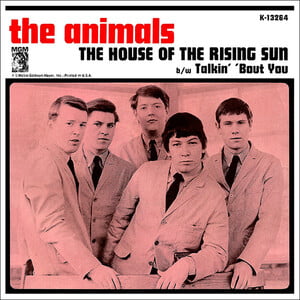February 16, 2024 —– Chart #233
Hello Music Friends,
Hey folks, welcome to another edition of Chart of the Week. Guess what? We’re not in the 70’s this week. We are going back to the 60’s. This is literally one of the first songs I learned to play on the guitar when I was a kid. I mean, everyone I knew learned to play this song.
“The House of the Rising Sun” is a traditional folk song, sometimes called “Rising Sun Blues”. It tells of a person’s life gone wrong in the city of New Orleans. Many versions also urge a sibling or parents and children to avoid the same fate. The most successful commercial version, recorded in 1964 by the British rock band The Animals, was a number one hit on the UK Singles Chart and in the US and Canada. As a traditional folk song recorded by an electric rock band, it has been described as the “first folk rock hit”.
The song was first collected in Appalachia in the 1930s, but probably has its roots in traditional English folk song. Like many folk songs, “The House of the Rising Sun” is of uncertain authorship. Musicologists say that it is based on the tradition of broadside ballads, and thematically it has some resemblance to the 16th-century ballad “The Unfortunate Rake”, yet there is no evidence suggesting that there is any direct relation.
Lomax also noted that “Rising Sun” was the name of a bawdy house in two traditional English songs, and a name for English pubs, and proposed that the location of the house was then relocated from England to the US by White Southern performers. In 1953, Lomax met Harry Cox, an English farm laborer known for his impressive folk song repertoire, who knew a song called “She was a Rum One” (Roud 2128) with two possible opening verses, one beginning
If you go to Lowestoft, and ask for The Rising Sun,
There you’ll find two old whores and my old woman is one.
The recording Lomax made of Harry Cox is available online. (Cox provides the alternate opening verse with the “Rising Sun” line at 1:40 in the recording.) It is considered extremely unlikely that Cox was aware of the American song. It is also lent credence by the fact that there was a pub in Lowestoft called The Rising Sun and by the fact that the town is the most easterly settlement in the UK (hence “rising sun”). However, doubt has been expressed as to whether Cox’s song has any connection to later versions.
An interview with Eric Burdon revealed that he first heard the song in a club in Newcastle, England, where it was sung by the Northumbrian folk singer Johnny Handle. The Animals were on tour with Chuck Berry and chose it because they wanted something distinctive to sing.
The Animals had begun featuring their arrangement of “The House of the Rising Sun” during a joint concert tour with Chuck Berry, using it as their closing number to differentiate themselves from acts that always closed with straight rockers. It got a tremendous reaction from the audience, convincing initially reluctant producer Mickie Most that it had hit potential, and between tour stops the group went to a small recording studio, De Lane Lea Studios on Kingsway in London to capture it.
The song was recorded in just one take on May 18, 1964, and it starts with a now-famous electric guitar A minor chord arpeggio by Hilton Valentine. According to Valentine, he simply took Dylan’s chord sequence and played it as an arpeggio. The performance takes off with Burdon’s lead vocal, which has been variously described as “howling”, “soulful”, and as “…deep and gravelly as the north-east English coal town of Newcastle that spawned him”. Finally, Alan Price’s pulsating organ part (played on a Vox Continental) completes the sound. Burdon later said, “We were looking for a song that would grab people’s attention”.
As recorded, “The House of the Rising Sun” ran four and a half minutes, regarded as far too long for a pop single at the time. Producer Most, who initially did not really want to record the song at all, said that on this occasion: “Everything was in the right place … It only took 15 minutes to make so I can’t take much credit for the production”. He was nonetheless now a believer and declared it a single at its full length, saying “We’re in a microgroove world now, we will release it“.
In the US, however, the original single (MGM 13264) was a 2:58 version. The MGM Golden Circle reissue (KGC 179) featured the unedited 4:29 version, although the record label gives the edited playing time of 2:58. The edited version was included on the group’s 1964 US debut album The Animals, while the full version was later included on their best-selling 1966 US greatest hits album, The Best of the Animals. The first American album release of the full version was on a 1965 compilation entitled Mickie Most Presents British Go-Go (MGM SE-4306), the cover of which, under the listing of “House of the Rising Sun”, described it as the “Original uncut version”. Americans could also hear the complete version in the movie Go Go Mania in the spring of 1965.
Grab your guitar and step back in time with this one.
Keep Rockin’,
Stan Bradshaw

That was a fantastic summary of this iconic song!!! It’s Penny’s favorite song — she play’s this song almost everyday on Spotify!!! via Google Nest…
Glad you enjoyed that one. It was one of the first songs I learned to play on guitar.